Return
Permafrost Talks
The calculated ABSOLUTE MINIMUM possible time to form very thick permafrost as that in Siberia, up to about 1600 meters, is 64,800 years !!
That frozen ground is called permafrost. Permafrost can have different characteristics
and be found in different forms. It can contain organic-rich soil or be sandy and rocky.
It can even be solid rock. It may contain frozen water or be relatively dry. But all
permafrost has one important characteristic in common. It is frozen. Permafrost is
ground that is below the freezing point of water (0°C or 32°F) for two or more years.
Permafrost is found at high latitudes like the Arctic and Antarctic. It is also common
at high altitudes - like mountainous areas – wherever the climate is cold. Today about
20% of the land surface is frozen permafrost. Permafrost is considered part of the
cryosphere because it is frozen. However, it is also often considered part of the
geosphere because it contains rocks and soils.
Below is a map (from USGS) which shows the extent of permafrost and the different types in
the northern hemisphere.
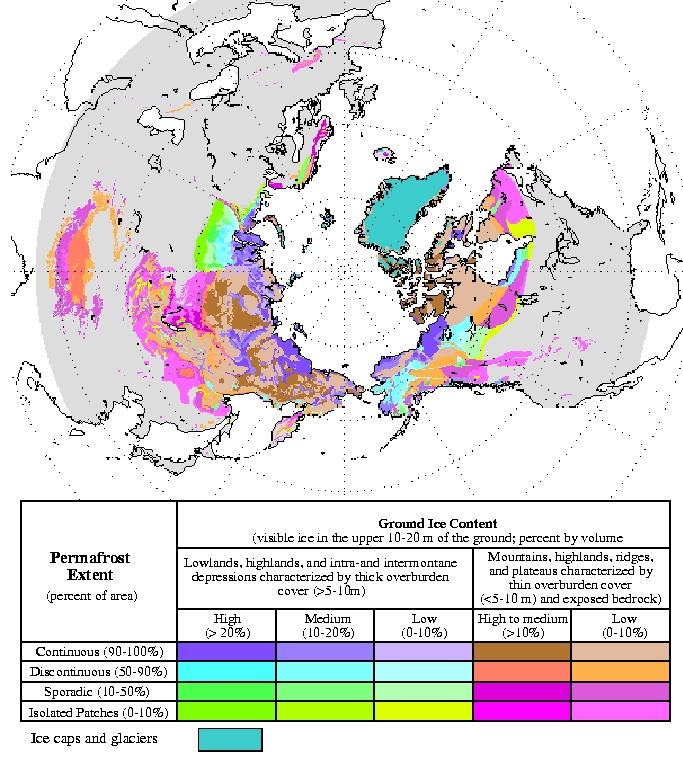
![[IMAGE]](ice_lgm.jpg)
|
In past times, during the ice age, continuous permafrost covered a much greater area than it does today, covering all of ice-free Europe south to about Szeged (southeastern Hungary) and the Sea of Azov (then dry land) and China south to Beijing. In North America, only an extremely narrow belt of permafrost existed south of the ice sheet at about the latitude of New Jersey through southern Iowa and northern Missouri.
When the ground under your feet is frozen, interesting things can happen. The
land may be covered with circles, polygons, or stripes, called patterned ground,
which form as the land freezes.
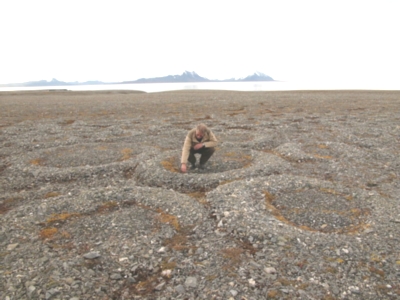
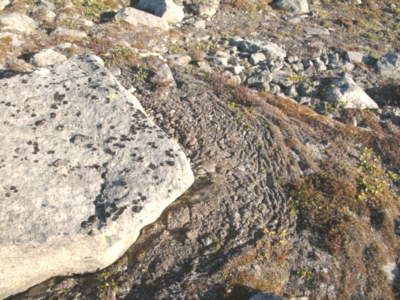
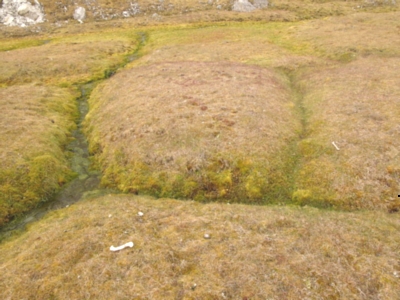
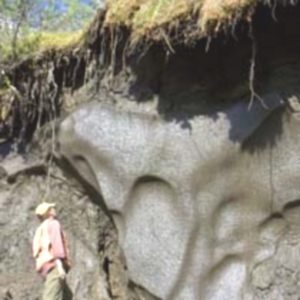
TL-stone rings TR-soil flow BL-ice wedge tops BR-Ancient ice wedge about 740,000 years old (see Appendix A)
Trees may be few and far between, their roots unable to penetrate the solid ground, leaving the land to only the short tundra plants or no plants at all. Unique hills called pingos, made mostly of underground ice, may dot the landscape, growing larger over time if more ice is added to their core. Or big blocks of land that were once flat may be thrust upward like detached puzzle pieces in areas called blockfields.
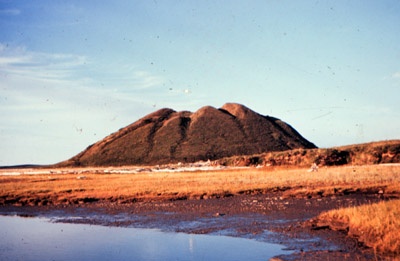
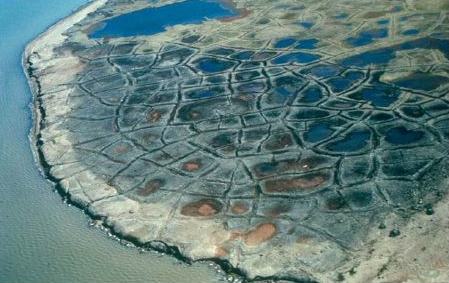
The top surface of permafrost - called the active layer – usually thaws and refreezes with the seasons. The active layer may only be half a meter thick or it may be as much at four meters thick. Plants can survive if there is an active layer because their roots can penetrate the softened active layer and they can find the water they need to survive.
In some areas of the world, permafrost extends very far underground. Under Barrow,
Alaska (US) there is 440 meters of permafrost and about 600 meters
at Prudoe Bay.
In areas of continuous permafrost and harsh winters the depth
of the permafrost has been measured at 1493 m (4510 ft) as in the northern Lena and Yana River
basins in Siberia. It took a very long time for the
ground to freeze to such depths. Shallower permafrost can form relatively quickly;
the first hundred meters of ground can freeze in only several hundred years. But
it took a much longer time, tens or even hundreds of thousands of years, for ground
to freeze to depths of several hundred meters. For example, in a mere 350 years of
cold climate the ground can freeze to about 80 meters depth, but it takes ten times
as long to freeze to about 220 meters depth. This is illustrated in the table below.
| Time (yr) | Permafrost Depth (m) |
|---|---|
| 1 | 4.44 (0.002759 mi.) |
| 350 | 79.9 (0.049648 mi.) |
| 3500 | 219.3 |
| 35000 | 461.4 |
| 100000 | 567.8 |
| 225000 | 626.5 |
| 775000 | 687.7 |
Needless to say the factors involved in permafrost formation to great depths are many and the calculations are very complex. However, considerable information on the permafrost is available from oil wells in the Prudhoe Bay, Alaska, area. See Appendix B for details. These results are presented in the following figure from Appendix B as the author is illustrating different scenarios.

As you can see the early stages of formation are quite quick and then slows down appreciably until the full present depth of 599.3 meters is reached. This formation took a practical estimated time of a half million years (500,740 years)!
The calculated ABSOLUTE MINIMUM possible time to form very thick permafrost as that in Siberia, up to about 1600 meters, is 64,800 years !
Conclusion:
The formation of deep layers of permafrost, those deeper than about 300 meters, is inconsistent with young Earth theories!!
Return
Appendix A
Yukon permafrost older than previously thought: Researchers
A swath of frozen mud and ice, inadvertently exposed by miners in central Yukon,
is proving to be scientific gold. Canada's foundation - half the country sits on
permafrost - may be more solid than some have suggested.
By Canwest News Service September 18, 2008
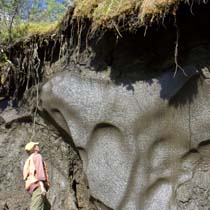
Ancient Permafrost Ice Wedge
The
permafrost turns out to be about 740,000 years old and contains the
oldest ice ever uncovered in North America, researchers say. It
predates the arrival of long-extinct creatures such as the woolly
mammoth, and has weathered some remarkable swings in the climate,
including two notable warm spells 120,000 and 400,000 years ago when
temperatures were higher than they are today.
All of which
indicates that Canada’s foundation - half the country sits on
permafrost - may be more solid than some have suggested.
“It
underscores the inherent resilience of permafrost,” said University of
Alberta geologist Duane Froese, lead author of a report Friday in the
journal Science describing the ancient permafrost found just south of
Dawson City.
The discovery suggests permafrost more than a few
metres below the surface, and the huge store of carbon it contains, may
be more stable than previously thought, he and his colleagues say.
Froese stresses, however, that the top few metres of permafrost are very much at risk.
“This
isn’t saying we are out of the woods or anything like that,” he said in
an interview. “The deep stores are probably stable, but we still have a
lot of . . . potential impacts from melting of shallow permafrost.”
Roads,
runways and building foundations have been shifting and heaving as the
top layer of frozen ground melts in the north, and the problems are
growing as temperatures climb. Froese said shallow permafrost is also
expected to release large amounts of carbon dioxide and methane gas
that could fuel more climate change and global warming.
But he
said the Yukon discovery shows the staying power of the deeper
permafrost, which exists under large areas of northern Canada, Alaska
and Siberia. In some areas, it’s believed to a kilometre deep, perhaps
even more.
It has long been assumed the ground froze about 100,000 years ago, said Froese. The Yukon find pushes the age way back.
A layer of ash from volcanic eruptions sits on top of the permafrost and
its ice wedges that were uncovered by a gold-mining operation, south of
Dawson City.
Froese and colleagues at the University of Toronto
and the Geological Survey of Canada in Victoria have dated the ash at
740,000 years. They say it was laid down on top the permafrost that was
at the surface when the eruptions occurred. The frozen material was
subsequently buried a few metres, where it appears to have been sitting
ever since.
“The geologic setting indicates that it was never more than a few metres below the surface,” Froese said.
Permafrost
is found under almost half of Canada and is described as the cement or
glue that holds the North together. It is "discontinuous," or found in
large patches, across much of the northern landscape. It is
"continuous" and frozen to great depths in the higher Arctic. The top
metre or two of permafrost thaws in summer, then refreezes as
temperatures plummet in winter. The repeated thawing and freezing
creates cracks in the ground that fill with water and form ice wedges,
a distinctive feature of permafrost.
Some climate models predict
the frozen ground will thaw extensively in response to global warming,
releasing huge volumes of stored carbon into the atmosphere that could
trigger catastrophic warming. The accuracy of these models, however, is
difficult to evaluate, because researchers know little about how
permafrost responded to warmer climates in the past.
Froese says
the long-lived permafrost in the Yukon is saying: "Well, slow down
here. Permafrost has survived in these areas and it has considerable
resilience."
He said more work is needed to better estimate what
happened to the permafrost in the warm interglacial periods 120,000 and
400,000 years ago, when forests grew much farther north than they do
today and average temperatures were two to three degrees higher. The
way these “natural experiments” of the past played themselves out can
provide valuable hints about what to expect in future, he said.
© (c) CanWest MediaWorks Publications Inc.
The permafrost turns out to be about 740,000 years old and contains the oldest ice ever uncovered in North America, researchers say. It predates the arrival of long-extinct creatures such as the woolly mammoth, and has weathered some remarkable swings in the climate, including two notable warm spells 120,000 and 400,000 years ago when temperatures were higher than they are today.
All of which indicates that Canada’s foundation - half the country sits on permafrost - may be more solid than some have suggested.
“It underscores the inherent resilience of permafrost,” said University of Alberta geologist Duane Froese, lead author of a report Friday in the journal Science describing the ancient permafrost found just south of Dawson City.
The discovery suggests permafrost more than a few metres below the surface, and the huge store of carbon it contains, may be more stable than previously thought, he and his colleagues say.
Froese stresses, however, that the top few metres of permafrost are very much at risk.
“This isn’t saying we are out of the woods or anything like that,” he said in an interview. “The deep stores are probably stable, but we still have a lot of . . . potential impacts from melting of shallow permafrost.”
Roads, runways and building foundations have been shifting and heaving as the top layer of frozen ground melts in the north, and the problems are growing as temperatures climb. Froese said shallow permafrost is also expected to release large amounts of carbon dioxide and methane gas that could fuel more climate change and global warming.
But he said the Yukon discovery shows the staying power of the deeper permafrost, which exists under large areas of northern Canada, Alaska and Siberia. In some areas, it’s believed to a kilometre deep, perhaps even more.
It has long been assumed the ground froze about 100,000 years ago, said Froese. The Yukon find pushes the age way back.
A layer of ash from volcanic eruptions sits on top of the permafrost and its ice wedges that were uncovered by a gold-mining operation, south of Dawson City.
Froese and colleagues at the University of Toronto and the Geological Survey of Canada in Victoria have dated the ash at 740,000 years. They say it was laid down on top the permafrost that was at the surface when the eruptions occurred. The frozen material was subsequently buried a few metres, where it appears to have been sitting ever since.
“The geologic setting indicates that it was never more than a few metres below the surface,” Froese said.
Permafrost is found under almost half of Canada and is described as the cement or glue that holds the North together. It is "discontinuous," or found in large patches, across much of the northern landscape. It is "continuous" and frozen to great depths in the higher Arctic. The top metre or two of permafrost thaws in summer, then refreezes as temperatures plummet in winter. The repeated thawing and freezing creates cracks in the ground that fill with water and form ice wedges, a distinctive feature of permafrost.
Some climate models predict the frozen ground will thaw extensively in response to global warming, releasing huge volumes of stored carbon into the atmosphere that could trigger catastrophic warming. The accuracy of these models, however, is difficult to evaluate, because researchers know little about how permafrost responded to warmer climates in the past.
Froese says the long-lived permafrost in the Yukon is saying: "Well, slow down here. Permafrost has survived in these areas and it has considerable resilience."
He said more work is needed to better estimate what happened to the permafrost in the warm interglacial periods 120,000 and 400,000 years ago, when forests grew much farther north than they do today and average temperatures were two to three degrees higher. The way these “natural experiments” of the past played themselves out can provide valuable hints about what to expect in future, he said.
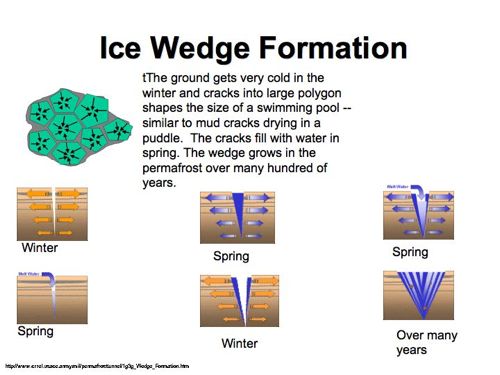
Appendix B
Permafrost Formation Time
Virgil J. Lunardini April 1995
Abstract: The age of permafrost is closely linked to the time required for soil systems to freeze, since the permafrost must be at least as old as the formation time. Cycles of freeze–thaw will complicate the relation between the freeze rate and the age. A model based on pure conduction heat transfer with freeze– thaw is used to predict the time required for a given thickness of permafrost to develop, either heterogenetically or syngenetically. The formation time is a function of the long-term geothermal gradient (initial temperature of the thawed soil), the ratios of the frozen to thawed thermal properties, and the temperature history of the upper surface of the permafrost (higher than the air temperature). The simple theory allows universal graphs to be produced that predict the formation time for a given thickness of permafrost. Realistic soil property ratios and paleotemperature scenarios will then lead to estimates of the formation time of permafrost for a specific site. The model indicates that deep permafrost (more than 1500 m) requires formation times on the order of the complete Quaternary Period.
How to get copies of CRREL technical publications: Department of Defense personnel and contractors may order reports through the Defense Technical Information Center: DTIC-BR SUITE 0944 8725 JOHN J KINGMAN RD FT BELVOIR VA 22060-6218 Telephone 1 800 225 3842 E-mail help@dtic.mil msorders@dtic.mil WWW http://www.dtic.dla.mil/ All others may order reports through the National Technical Information Service: NTIS 5285 PORT ROYAL RD SPRINGFIELD VA 22161 Telephone 1 703 487 4650 1 703 487 4639 (TDD for the hearing-impaired) E-mail orders@ntis.fedworld.gov WWW http://www.fedworld.gov/ntis/ntishome.html A complete list of all CRREL technical publications is available from: USACRREL (CECRL-LP) 72 LYME RD HANOVER NH 03755-1290 Telephone 1 603 646 4338 E-mail techpubs@crrel.usace.army.mil For information on all aspects of the Cold Regions Research and Engineering Laboratory, visit our World Wide Web site: http://www.crrel.usace.army.mil . CRREL Report 95-8 US Army Corps of Engineers Cold Regions Research & Engineering Laboratory Permafrost Formation Time Virgil J. Lunardini April 1995 Prepared for OFFICE OF THE CHIEF OF ENGINEERS Approved for public release; distribution is unlimited. PREFACE This report was prepared by Dr. Virgil J. Lunardini, Mechanical Engineer, Applied Research Division, Research and Engineering Directorate, U.S. Army Cold Regions Research and Engineering Laboratory. This study was primarily funded by U.S. Army Strategic Environmental Research and Development Program, Deep Permafrost Borehole Sites in Alaska, 2 6.00 78 203, and DA Project 4A161102AT24, Task BS/0045, Climate Impacts on Permafrost Distribution and Integrity. The author thanks Dr. Gary Phetteplace and Michael Ferrick of CRREL for their technical review of this report. The contents of this report are not to be used for advertising or promotional purposes. Citation of brand names does not constitute an official endorsement or approval of the use of such commercial products.
INTRODUCTION
The age of permafrost is of interest to biologists, geophysicists and engineers. Clearly, permafrost must be at least as old as the time it took for it to form; thus, the formation time of permafrost can be considered its minimum age. A volume of permafrost can be much older than this since it may exist for many years after formation. This report will examine the formation time of permafrost using a pure heat conduction model. As we shall see, the surface temperature history of the soil mass is critical for any prediction of the permafrost formation time. Since the formation time of permafrost is expected to be on the order of millennia, it is necessary to examine the geophysical record to obtain some bounds on realistic surface temperatures that the Earth has experienced during the time when permafrost was growing. First, we will discuss permafrost and paleotemperature scenarios, then we will formulate a mathematical model of permafrost growth, and, finally, we will examine some predictions by the model of permafrost formation times.
Permafrost is a widespread phenomenon that has been and still is greatly misunderstood. The term “permafrost” is generally attributed to S.W. Muller (1945), who apparently coined the name in place of the more awkward terms: permanently frozen ground or permanent frost. Bryan (1946) suggested the term “pergelisol,” but this has not been adopted except in the French literature. In order to understand the concept, let us look at a general definition given in Lunardini (1981a):
Permafrost describes the thermal condition of earth materials (sand, glacial till, organic matter, etc.) when their temperature remains at or below 32°F (0°C) continuously for a significantly long time, but not necessarily for an entire geological period. It does not include earth materials that drop be low 32°F during one winter and remain below 32°F through the following summer and into the next winter, although for practical engineering purposes such materials may be included.
Clearly, permafrost is not so much a material as it is the thermal state of ordinary soil systems. It does not include systems that are at or below 0°C, but contain no earth materials, e.g., ice caps, glaciers and icebergs. There is no agreement on the minimum time during which the material must remain below 0°C to qualify as permafrost. Soils that freeze during an exceptionally severe winter and survive for 1 or 2 more years are called “pereletoks,” and often are not classified as permafrost (Swinzow 1969).
The existence of permafrost is a result of the history and the present state of the energy balance at the Earth’s surface—measured by the surface temperature—and the deep Earth heat flow. If permafrost exists and the net yearly gain of energy by the entire permafrost volume is equal to the net loss of energy, then the permafrost will remain stationary, while an excess heat gain over heat loss will result in a net loss of frozen material. Given the same energy balances, however, i.e., net gain of energy over the year, one region may have permafrost (albeit degrading) while another will not. This is ascribable to the thermal history of the frozen ground in the two areas. Though both are losing or have lost permafrost, one region may have started with a larger volume of permafrost than the other. Thus, the present energy flow conditions may be such that permafrost cannot exist in one region, whereas it will subsist in another area, although in a receding form often referred to as “relic permafrost.”
In this sense previous glaciation has very likely played an important role in the present existence of permafrost in marginal areas. It is safe to conclude that little, if any, permafrost exists beneath nonpolar glaciers, but once they withdraw, permafrost may rapidly form and grow. So, previously glaciated regions will show a lesser volume of frozen ground than unglaciated regions with similar climatic histories. In this regard it is significant that Canada was heavily glaciated while Russia (Siberia) had little permanent glaciation. Thus, the permafrost thickness in Siberia is much greater than in Canada, although the climates are similar.
Since the energy balance involves meteorological conditions, surface vegetation, topography and soil conditions, we can anticipate that we will find no simple correlation for the existence of permafrost in the marginal or discontinuous regions. Permafrost does exist far south of the usually accepted limits in scattered patches almost always associated with high altitudes and, thus, microclimates similar to the usual permafrost regions.
Origin and existence of permafrost
In discussing the present distribution of permafrost, questions often arise concerning its origin and age. These two concepts should be clearly differentiated, since they deal with two separate phenomena. The age of a particular deposit of permafrost is the time that has elapsed since the freezing of the soil system. Actually, it may be very difficult or impossible to determine this age because thawing and freezing may cycle at long intervals and different frequencies in different regions of the Earth. Thus, the ages of two “similar” deposits of permafrost may be quite different. In this regard, the presence of preserved animal remains may be a reliable clue to the age of a deposit of frozen ground. The age of permafrost is a question of significance and may be useful to paleontologists, paleobotanists, etc. The present thermal state of the permafrost—temperature, degradation, aggradation, etc.—is of interest to engineers.
The origin of permafrost involves the question of the conditions under which it can form and grow. These same conditions will explain the present existence of permafrost at a given location. As the conditions for the origin of permafrost are dynamic, it is certainly possible that areas now lacking permafrost once had these underlying frozen strata, and that the present regions of permafrost could once have been thawed. In other words, the present existence of permafrost depends upon two things: the proper energy exchange conditions and the thermodynamic state of the permafrost mass itself. The first of these conditions has little to do with past climatic conditions, but the second is a function of the complete thermal history of the permafrost and is thus related to past climate. In this sense, it is incorrect to describe permafrost simply as a legacy of the last great ice age. It is possible that some, perhaps most, permafrost had its origin at the beginning of the Pleistocene era (Brown 1964), but this should not imply that the intervening thermal conditions were without significance.
From the above discussion, it should be clear that the formation and existence of permafrost are related to the present and historical conditions of energy exchange between the soil and the atmosphere. Nevertheless, it is not possible to state these conditions in a simple, precise manner that will allow us to define unique permafrost indicators.
Over a sufficiently long time span, the energy exchange will be periodic, and, averaged over a number of periods, the net energy flow for a given soil volume will determine its thermodynamic state. Dynamic equilibrium of the energy flows may exist such that the soil is perennially frozen or the thermodynamic state of the soil may be varying because of an imbalance of the cyclic energy flows. The original formation of permafrost depends upon a net periodic (yearly) loss of energy from the soil volume that must persist for many, many years for the permafrost to attain great thicknesses. The maintenance of the present thermodynamic state of permafrost requires only that the net energy flow averaged over a number of years be zero.
Paleotemperatures
The thermal history of permafrost is greatly influenced by the long-term temperature variations experienced
at its upper surface. The relative mean global temperature deduced from oxygen isotope data is shown
for the past 180 million years in Figure 1 (Eddy and Bradley 1991). There was probably little or no permafrost
prior to the late Tertiary Period and certainly none for 100 million years prior to the long-term cooling